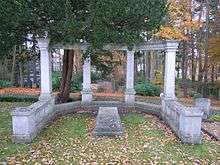Nowroji Saklatwala
| Sir Nowroji Saklatwala | |
|---|---|
 The tomb of Nowroji Saklatwala in Brookwood Cemetery | |
| Born |
1875 Bombay, British India |
| Died | 1938 (aged 63) |
| Alma mater | University of Bombay |
| Occupation | Former chairman of Tata Group |
| Religion | Zoroastrian |
| Parent(s) | Bapuji and Virbaiji (néé Tata) |
| Relatives | Jamshetji Tata (uncle) |
Sir Nowroji Saklatwala, KBE, CIE (1875–1938) was the third chairman of the Tata group from 1932 till his sudden death in 1938 due to a heart attack.[1]
He was the son of Bapuji Saklatwala and Virbaiji Saklatwala (néé Tata). His mother Virbaiji was the sister of Jamshetji Nusserwani Tata.[2] He completed his studies at St. Xavier College,[3] joined the Tata group in 1899 as a clerk in Svadeshi Mills in Mumbai. Within twenty years, he rose to be the head of the firm. He was the first non-Tata to make it to the top,[4] and worked closely with Dorabji Tata.[5] When Dorabji died in 1932, he became the Chairman of the Tata Group and had the task of consolidating the company during the Depression years.[5]
Closely connected with Indian cricket, Saklatwala played for the Parsees team during 1904-05, but stopped playing actively due to business pre-occupations. As a cricket player he represented the Parsees against the Europeans in 1904.[3]
He was the first Chairman of the Cricket Club of India after its inception in 1933 till his death and was instrumental in the development of Brabourne Stadium, for which he also donated a large sum of money.[3]
Saklatwala was appointed a Companion of the Order of the Indian Empire (CIE) in the 1923 New Year Honours list,[6] knighted in the 1933 Birthday Honours list[7] and further knighted as a Knight Commander of the Order of the British Empire (KBE) in the 1937 Coronation Honours list.[8] He is buried in the Parsi Section of Brookwood Cemetery.
References
- ↑ "The Enigma called Pallonji Mistry". Retrieved 2008-03-09.
- ↑ Tata Family tree
- 1 2 3 "cricinfo.com". Retrieved 2008-03-09.
- ↑ "The Tata Titans". The Hindu. Retrieved 15 December 2014.
- 1 2
- ↑ London Gazette, 1 January 1923
- ↑ London Gazette, 3 June 1933
- ↑ London Gazette, 11 May 1937